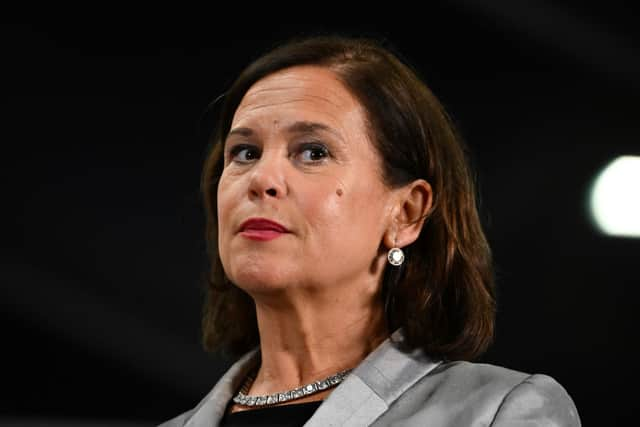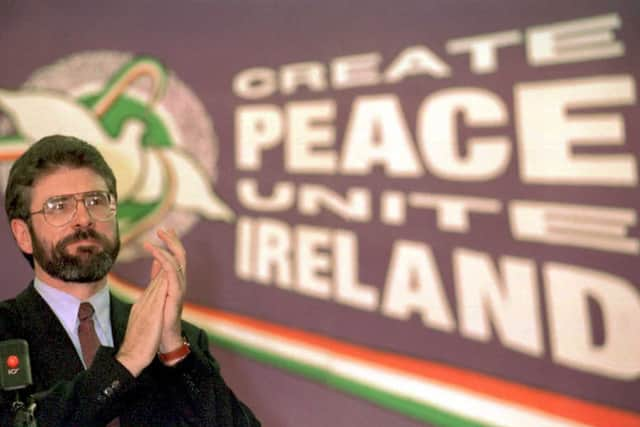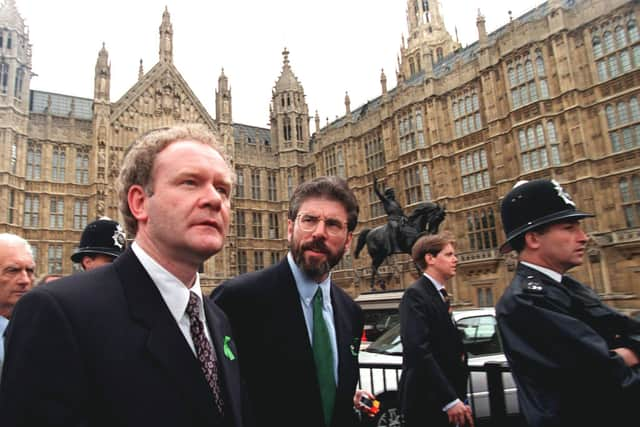What does Sinn Féin mean? English translation of party name, origins and IRA links explained
and live on Freeview channel 276
Sinn Féin is an Irish republican political party, but what does its name mean and what are the origins of the party?
With the party on course for a historic win in the 2022 Northern Ireland election, here’s what you need to know.
What does Sinn Féin mean?
In English, its name is translated as ‘(We) Ourselves’.
What is Sinn Féin?
Advertisement
Hide AdAdvertisement
Hide AdSinn Féin is the only political party that is active in both the Republic of Ireland and Northern Ireland.
There is one overall Leader of Sinn Féin, which operates as a single organisation across the Republic of Ireland and Northern Ireland.
The current Sinn Féin President is Mary Lou McDonald, who was elected in 2018.


Prior to this, Gerry Adams had led the party for over 30 years.
Advertisement
Hide AdAdvertisement
Hide AdIn the 2019 General Election, Sinn Féin received 22.8% of the Northern Irish vote, winning seven of Northern Ireland’s 18 seats.
The party currently holds seven seats in the House of Commons. However, Sinn Féin MPs refuse to take up their seats as they would have to swear an oath of allegiance to the Queen in order to do so.
In the Northern Ireland Assembly at Stormont, Sinn Féin also currently holds 27 out of a total 90 seats, with a further 105 councillors across Northern Ireland.
In the Republic of Ireland, Sinn Féin won 24.5% share of the vote in the 2020 Dáil Éireann election.
What are the origins of Sinn Féin?
Advertisement
Hide AdAdvertisement
Hide AdArthur Griffith helped found the Sinn Féin movement in 1905.
To achieve nationalist aims, he advocated passive resistance, with Irish MPs to withdraw from Westminster and form a national assembly in Ireland.
He urged the need for high protective tariffs to enable Ireland to exploit its domestic market, develop its own resources, support itself and end emigration.
Sinn Féin obtained notoriety for its anti-British propaganda and later, in wartime, its opposition to military recruitment.
Advertisement
Hide AdAdvertisement
Hide AdIt was widely held responsible in both Britain and Ireland for the Easter Rising, though as an organisation it had not participated.
In the December 1918 general election, Sinn Féin won 73 of the 103 Irish seats.
Sinn Féin then formed the Dail government in Dublin in 1919 and declared Ireland to be an independent republic.
However, its political activities were overshadowed by the Irish Republican Army’s (IRA) military campaign in the Anglo-Irish War (1919-21). This was a campaign which Sinn Féin assisted but never effectively controlled.


Advertisement
Hide AdAdvertisement
Hide AdIn the 1970s, Sinn Féin was divided over the issue of parliamentary abstentionism.
One wing of the party pushed any elected representatives to take up their elected seats and another wing strongly opposed this.
The anti-abstentionists split to form Official Sinn Féin, later known as Sinn Féin – The Workers’ Party and then simply as ‘The Workers’ Party’.
In the late 1970s and early 1980s, Sinn Féin shifted from its military focus to becoming more politically active. It won over 100,000 votes in the 1983 General Election, with Gerry Adams being elected as the MP for Belfast West in 1983.
Advertisement
Hide AdAdvertisement
Hide AdIn 1986, the party decided to end its policy of abstentionism in the Irish Dáil in Dublin.


When the Provisional IRA declared a ceasefire in 1994, Sinn Féin was initially allowed to join talks with the British government, but the decommissioning of all IRA weapons was made a condition to the party’s ongoing inclusion in the talks, leading to an end in the initial ceasefire.
After the Labour Party was elected to government in 1997, peace talks restarted and a new ceasefire was announced.
The multi-party talks with the British government led to the Good Friday Agreement.
This resulted in a permanent ceasefire and a new devolved Northern Irish administration known as the Northern Ireland Assembly.
Comment Guidelines
National World encourages reader discussion on our stories. User feedback, insights and back-and-forth exchanges add a rich layer of context to reporting. Please review our Community Guidelines before commenting.
